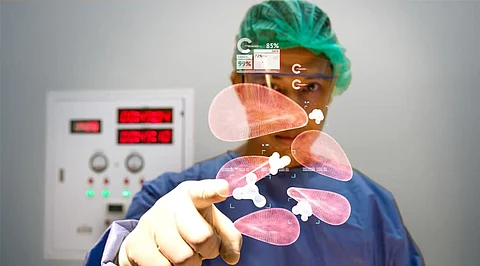

Artificial Intelligence has been playing a growing role in the world in the last few decades. What most don't understand is that artificial intelligence introduces itself in numerous structures that sway everyday life. Signing into your social media, email, car ride services, and online shopping platforms, etc. all include artificial intelligence algorithms to improve customer experience. AI in healthcare is growing quickly; explicitly, in diagnostics and treatment management.
As of late, AI applications in healthcare have sent huge waves across medical services, fuelling a conversation of whether AI doctors will in the end supplant human doctors in the future. However, experts believe that human doctors won't be supplanted by machines soon, yet the use of artificial intelligence in healthcare can help doctors to settle on better clinical choices or even supplant human judgment in certain functional areas of healthcare.
One emerging application of AI in healthcare is a new study led by the research team of Northwestern University faculty and alumni, created and applied artificial intelligence, or machine learning algorithms to physiological information — including respiratory rate, oxygen levels, pulse rate, body temperature, blood pressure, etc. from patients with chronic pain suffering sickle cell illness. Not exclusively did the scientists' methodology beat baseline models to gauge subjective pain levels, it additionally distinguished changes in pain and abnormal pain fluctuations.
The team of researchers utilized data from 46 adults and kids with sickle cell sickness over a consolidated total of 105 hospital stays, taking a look at the physiological information alongside patient-reported pain scores to create models that could derive pain levels and identify changes in pain level through machine learning
Presently, patients should evaluate their pain on a scale of zero to 10. This can be a troublesome assignment on the grounds that numerous individuals experience pain in an unexpected way, and little kids and unconscious patients can't rate their pain by any means. The scientists say that these subjective evaluations of pain could be enhanced with a more objective, less intrusive, data-driven approach to help physicians with a more accurate treatment plan.
The researchers then analyzed their new models against existing ones that attempt to evaluate levels of pain but that don't use physiological estimations. The new models outflanked the current ones.
According to Daniel Abrams at Northwestern University in Illinois, "The big picture is that we want to better understand how people experience pain. We're hoping that the long-term outcome of this line of research is a more quantitative approach to pain management."
Prior to this use of AI in pain management, Professor Jeff Hughes, Chief Scientific Officer at PainChek, clarifies how smart automation and AI in healthcare can reform pain assessment in patients with dementia who find it very difficult to communicate.
PainChek was created as a compelling solution for this issue. Its novel blend of automated facial-analysis technology and smart automation empowers care takers and healthcare experts to look for the presence of pain when it isn't self-evident, to evaluate the intensity of pain and screen the effect of treatment to optimize and witness the overall quality of care.
This information is then integrated with non-facial features seen by the application user and information through a range of digital checklists, which together permits automatic calculation of a total pain score and the task of a pain intensity level.
There are different impacts of AI in healthcare. Commonly, AI used in healthcare leverages a web data set permitting doctors and experts to access a lot of diagnostic resources. As doctors are profoundly knowledgeable in their field and are up-to-date with present research, AI technology in healthcare incredibly builds a quicker result that can be matched with their clinical knowledge.
Nonetheless, artificial intelligence in healthcare presents numerous apprehensions as discussed, particularly in the clinical setting, of in the long-run substituting or lowering down the requirement for human doctors. In any case, so much research and data have shown that it is almost certain that AI in healthcare will benefit and improve clinical diagnostics and decision making as opposed to lessen clinician need.
The opportunities for AI applications in healthcare from emergency clinics and primary care, to home care, are huge. The use of artificial intelligence in healthcare can automate patient assessment and eliminate assessor bias. It can assess patient risk, for example, of a patient building up a specific disease, analyze illness, for instance, by deciphering ECG results and X-ray pictures, select the ideal treatment dependent on a patient's clinical history and the results of clinical trials, and monitor disease and recognize early warning signs of deterioration.
The use of AI in healthcare will be driven by the availability of big data on which to train predictive algorithms, which help (instead of supplanting) human doctors, encourage curiosity-based reasoning, empower collaboration and eliminate unremarkable tasks, thus, improving patient care.
